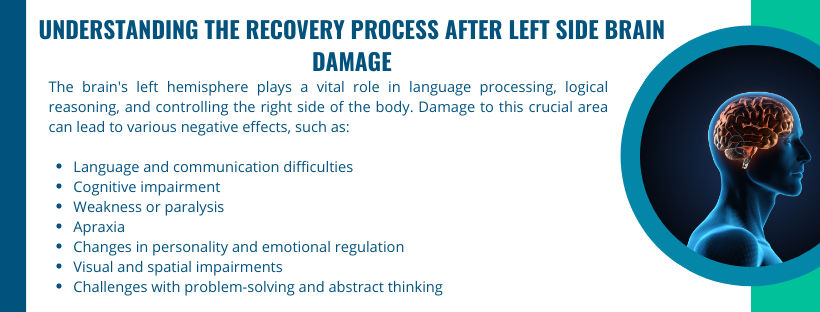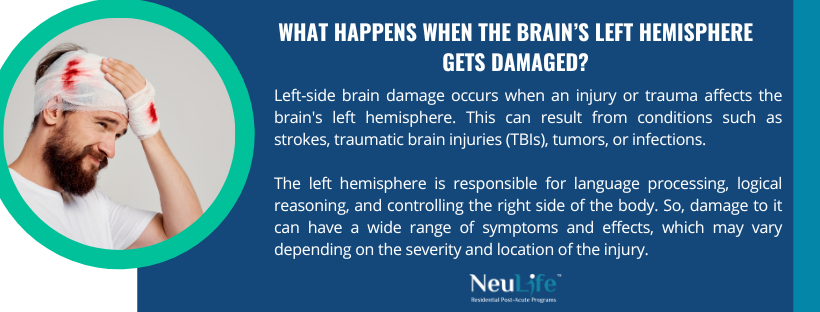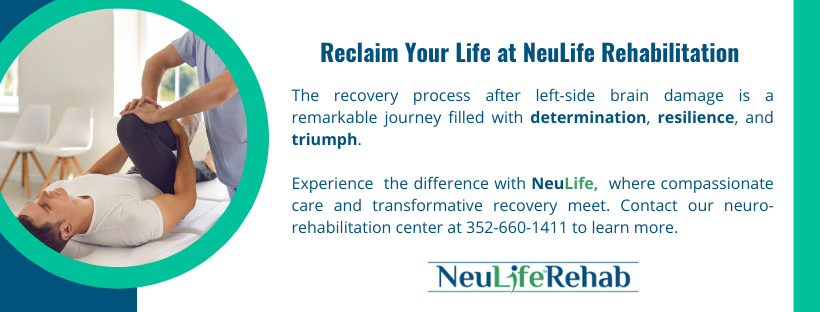The brain's left hemisphere plays a vital role in language processing, logical reasoning, and controlling the right side of the body. Damage to this crucial area can lead to various cognitive, motor, and language impairments.
In this blog post, we embark on a journey to understand the challenges faced by individuals with left-side brain injury and the unique restoration process that lies ahead. By gaining a deeper understanding of this journey, we can offer support, guidance, and hope to those on the path to recovery.
Left-side brain damage occurs when an injury or trauma affects the brain's left hemisphere. This can result from conditions such as strokes, traumatic brain injuries (TBIs), tumors, or infections.

The left hemisphere is responsible for language processing, logical reasoning, and controlling the right side of the body. So, damage to it can have a wide range of symptoms and effects, which may vary depending on the severity and location of the injury.
Here are some common symptoms associated with left-side brain damage:
One of the prominent effects of left-side brain injury is aphasia, a language impairment that can affect speaking, understanding, reading, and writing. Individuals may struggle to find the right words, form coherent sentences, or comprehend written or spoken language.
Damage in the brain’s left hemisphere can impact various cognitive functions, including memory, attention, problem-solving, and logical reasoning. Individuals may experience difficulties with concentration, multitasking, organizing thoughts, and making decisions.
The brain’s left hemisphere controls the motor functions of the right side of the body. Therefore, damage to the left hemisphere can lead to weakness or paralysis on the right side, known as hemiparesis or hemiplegia. This can affect movement, coordination, and balance.
Injury to the left side of the brain can result in apraxia一a motor planning disorder. It can be challenging to perform purposeful movements or coordinate sequential actions, such as buttoning a shirt or using utensils.
Some individuals may experience personality changes, emotional difficulties, or mood disorders after left-side brain damage. This can include irritability, impulsivity, depression, anxiety, or difficulties controlling emotions.
Left-side brain damage can affect visual processing and spatial awareness. Individuals may struggle with depth perception, judging distances, or recognizing objects or faces.
The left hemisphere is involved in logical and analytical thinking. Damage to this area can impact problem-solving abilities, abstract thinking, and understanding of complex concepts.
Embarking on the road to recovery after brain damage can be both challenging and rewarding. Here’s what typically happens during a patient’s recovery process:
The journey typically begins with immediate medical interventions and treatments. Medical professionals will assess the extent of the damage and create a personalized treatment plan. This may involve medications, surgeries, and therapies to stabilize the condition and promote healing.
As the initial stage progresses, rehabilitation therapies take center stage in the recovery process. These therapies are designed to help individuals regain lost functionality, relearn skills, and adapt to any remaining impairments.

Here are some examples of therapies performed during this stage:
Neuroplasticity, a remarkable property of the brain, also plays a significant role in the recovery journey. The brain possesses the ability to rewire itself and form new neural connections. This process allows other brain regions to compensate for the damaged areas.
By engaging in targeted therapies and exercises that promote neuroplasticity, individuals can maximize their potential for recovery.
Physical rehabilitation is crucial in restoring motor functions and coordination. Individuals can improve muscle strength, range of motion, and balance through tailored exercises and techniques. Some examples of specific exercises that a patient might encounter during their physiotherapy sessions include the following:
Physical therapists work closely with patients, guiding them through exercises that target specific areas affected by brain damage. Over time, these efforts can lead to increased independence and improved quality of life.
Cognitive rehabilitation focuses on retraining cognitive abilities that may have been impaired due to left-side brain damage. Cognitive therapists employ various techniques and exercises to enhance memory, attention, problem-solving skills, and executive functions. This includes the following:
A qualified cognitive therapist or neuropsychologist will assess the individual's cognitive profile and design a personalized rehabilitation program. Consistency, repetition, and gradual progression of exercises are critical factors in promoting cognitive recovery after TBI.
Individuals can regain mental sharpness and adapt to residual cognitive challenges by engaging in cognitive rehabilitation.
Emotional and psychological support also plays a vital role in the recovery process. Left-side brain damage can lead to emotional changes, including mood disorders, depression, and anxiety.
Some of the most common strategies used to address these challenges during the recovery process include the following:
Individual or group therapy sessions can provide a safe space to express emotions, explore coping mechanisms, and develop strategies to manage emotional difficulties.
Therapists can employ techniques such as cognitive-behavioral therapy (CBT), mindfulness-based approaches, or acceptance and commitment therapy (ACT) to address specific emotional concerns.
In some cases, medication may be prescribed to help manage mood disorders or emotional symptoms. A psychiatrist or neurologist can assess the individual's needs and prescribe appropriate medications to alleviate symptoms such as depression or anxiety.
Joining support groups or connecting with others who have experienced similar challenges can provide a sense of belonging, understanding, and peer support.
Sharing experiences, insights, and coping strategies within a supportive community can immensely benefit emotional well-being.
Learning and practicing stress management techniques can help individuals cope with psychological changes. Techniques such as deep breathing exercises, relaxation techniques, mindfulness, or engaging in hobbies and activities that bring joy and relaxation can effectively reduce stress levels.
By addressing emotional challenges, implementing coping strategies, and fostering a supportive environment, individuals can navigate the psychological changes associated with left-side brain damage with resilience and improved well-being.
Recovery from left-side brain damage necessitates a multidisciplinary approach and a robust support system. A multidisciplinary team typically includes healthcare professionals such as:
These professionals collaborate to develop a comprehensive treatment plan tailored to the individual's specific needs.
Furthermore, the support of family and friends is invaluable during the recovery journey. Loved ones can provide emotional support, encouragement, and motivation to keep pushing forward.
They can help create a nurturing environment that fosters recovery and assists in daily activities. Open communication, empathy, and patience are vital in fostering a supportive network that understands the challenges and celebrates the victories along the way.
The recovery process after left-side brain damage is a remarkable journey filled with determination, resilience, and triumph.

By understanding the definition, stages, and critical factors involved, individuals and their loved ones can navigate this path with more confidence and hope.
Remember, each milestone reached is a testament to the power of the human spirit. So, let us continue supporting and uplifting one another as we strive towards restoration and reclaiming lives after left-side brain damage.
Neulife stands as the foremost rehabilitation provider for individuals undergoing the journey of traumatic brain injury (TBI) recovery. With a focus on post acute rehab, Neulife offers comprehensive care for individuals with the following:
As an inpatient facility, we ensure round-the-clock care and support for residents. We are committed to providing exceptional rehabilitation services with a dedicated team of professionals, state-of-the-art facilities, and a patient-centered approach.
Experience the difference with Neulife, where compassionate care and transformative recovery meet. Contact our neuro rehabilitation center at 352-660-1411 to learn more.
The material contained on this site is for informational purposes only and DOES NOT CONSTITUTE THE PROVIDING OF MEDICAL ADVICE, and is not intended to be a substitute for independent professional medical judgment, advice, diagnosis, or treatment. Always seek the advice of your physician or other qualified healthcare providers with any questions or concerns you may have regarding your health.

We know that choosing the next step in your recovery from a catastrophic illness or injury is complex. Together, we can help you take the next step.
Contact us with any questions today.